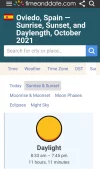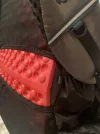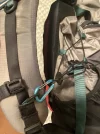U20C_Katherine
Member
- Time of past OR future Camino
- Future
As it is my first and very spontaneous camino (I’m off to Europe in few days), I am trying to do it as wisely as I can within my own time and research/planning limitations. I’m definitely thinking about traveling very light, but I am afraid of going too barebones… so here are some questions that may help tons.
Note: doing the Primitivo route and it is supposed to rain every day next week.
1. Walking sticks- yes or no? Should I bring them from home or get them in Oviedo? (Making my amazon shopping list now)
2. Sleeping bag- is it absolutely necessary to have one?
3. Hiking pants - never owned a pair and I usually use running leggings for all of my one day hikes (when they happen)
4. Towel!!! - I’d never think of brining one, but I just read somewhere I should not forget one.
5. Bottle - is a liter one okay? I read there is no water on some stretches and it makes me think if that is enough (don’t want to overpack if I don’t have to.
6. Sandals - so many people mention I take sandals in addition to my hiking shoes - hiking sandals? Trying to figure out what they mean and if it just relevant for the summer. I’m assuming I should take sandals for showers etc
7. Locks - Yes? No? I don’t know what they are are for, but I see them mentioned.
8. Hair and body products - do I need my own shampoo and body wash, etc?
9. Socks and underwear- I’m thinking of 3-4 each assuming I can wash them as I go. Where do you usually dry them? Do they dry fast? What is the best type to take? I hear smart wool, but does it dry overnight?
10. Medical supplies- someone I know mentioned I should take some painkillers, bandage tape, baby powder, cooling lotions for feet. Any thoughts? If there is something absolutely unwise to not take - what is it?
11. Head light (flashlight) - yes no? Necessary?
12. Waterproof backpack vs backpack rain cover?
ANYTHING ELSE?
I’m probably overthinking, but I’m worried to end up being underprepared since the little voice in my head says - keep it as light as possible and I’m questioning EVERYTHING.
Thank you to all of you who will take time to read this.
Note: doing the Primitivo route and it is supposed to rain every day next week.
1. Walking sticks- yes or no? Should I bring them from home or get them in Oviedo? (Making my amazon shopping list now)
2. Sleeping bag- is it absolutely necessary to have one?
3. Hiking pants - never owned a pair and I usually use running leggings for all of my one day hikes (when they happen)
4. Towel!!! - I’d never think of brining one, but I just read somewhere I should not forget one.
5. Bottle - is a liter one okay? I read there is no water on some stretches and it makes me think if that is enough (don’t want to overpack if I don’t have to.
6. Sandals - so many people mention I take sandals in addition to my hiking shoes - hiking sandals? Trying to figure out what they mean and if it just relevant for the summer. I’m assuming I should take sandals for showers etc
7. Locks - Yes? No? I don’t know what they are are for, but I see them mentioned.
8. Hair and body products - do I need my own shampoo and body wash, etc?
9. Socks and underwear- I’m thinking of 3-4 each assuming I can wash them as I go. Where do you usually dry them? Do they dry fast? What is the best type to take? I hear smart wool, but does it dry overnight?
10. Medical supplies- someone I know mentioned I should take some painkillers, bandage tape, baby powder, cooling lotions for feet. Any thoughts? If there is something absolutely unwise to not take - what is it?
11. Head light (flashlight) - yes no? Necessary?
12. Waterproof backpack vs backpack rain cover?
ANYTHING ELSE?
I’m probably overthinking, but I’m worried to end up being underprepared since the little voice in my head says - keep it as light as possible and I’m questioning EVERYTHING.
Thank you to all of you who will take time to read this.


























